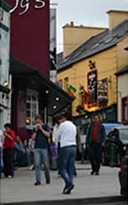The fastest route to Limerick from Larne is probably due south to Dublin and then across to the West, the route we took as a family when we first visited Ireland together on the weekend of the Good Friday agreement. At that time, the IRA and Unionist cease-fires had been in operation for several years and the border checkpoints, while still very visible, were not in use. However, I vividly recall the gradual realisation that the alternating villages we drove through: one prosperous and brightly bedecked with red, blue and white painted kerbstones, followed by one more down at heel with a large church in the middle, were in fact alternating protestant and catholic villages, bringing home so sharply the social as well as political and religious differences.
Whether it is passing time, or simply a different route, but I didn’t notice the extreme differences this time. However some things don’t change and beside the road, strapped to each lamppost, flap the Union Flag, the flag of St George with the hand of Ulster in the middle and even Scotland’s flag of St Andrew, but never the flag of St Patrick nor, of course, the tricolour1! Like Norman castles in Wales, masonry also remains, and the heavily armoured police stations contrast so strongly with the bungalow with its ‘Police’ sign in Tiree.
As I had Saturday and Sunday to get to Limerick, rather than driving directly I planned to go to Doolin for the night. However, not content with this detour, I decided also to go to Westport on the way. I don’t fully understand this Celtic longing for the western seaboard. Is it deep in my blood from birth, or borne from stories of the downed cantref beyond Aberdyfy and Tír na nÓg? It is certainly not America, but somewhere out there in the Atlantic, caught between the wave trammelled coast and the crack in the earth that is the mid-Atlantic ridge, is a path into fairyland and myth that draws at something deep in the heart.
My route south from Larne took me through places that evoked again those childhood memories: Omagh, Antrim, and road signs to others: Enniskillen, Londonderry. Like South Africa, it seemed so impossible that things could ever change and yet, despite problems still in both, it is a different world; hope still for other parts of the world that today seem equally impossible.
 In those days there would have been check-points at the border, but travelling now I never even noticed a sign to say when I crossed from Northern Ireland to Eire. However, as I drove through Ballyshannon I had no doubts that I was in the South: bright coloured shop fronts and ramshackle road signs, a country whose spirit is far more like southern Europe, than the cooler Northern blood that often mistakes tidiness for godliness — what happened to the hot fire that flowed through the veins of Visgoth and Viking?
In those days there would have been check-points at the border, but travelling now I never even noticed a sign to say when I crossed from Northern Ireland to Eire. However, as I drove through Ballyshannon I had no doubts that I was in the South: bright coloured shop fronts and ramshackle road signs, a country whose spirit is far more like southern Europe, than the cooler Northern blood that often mistakes tidiness for godliness — what happened to the hot fire that flowed through the veins of Visgoth and Viking?
I would have loved to have more time to stop along the way, camp on Boa Island at the top of Loch Erne looking out at the hills that tumble into the water across the Loch, or climbing Benbulben that, while gentler from the West and South, to the North rises square faced and square sided like a wooden-block mountain in child’s counterpane landscape. However, I did not stop and drove on towards the West, through the thick traffic near Sligo, and on into the County Mayo countryside. It would have been good to stop and stare, to spend time savouring each place; and given time I would do so, but with limited time I always choose to move rather than stay, to feel the miles flow past whether by foot or car. Like the thirst for the western shore, the itinerant spirit runs deep in my heart, and as a child I dreamed of being a gypsy or a tramp, living along the paths of the land.
next Serendipity and Song — Westport to Doolin
- To be fair south of the border tourist shops accept payment in euro or US dollars, but not pounds (not even Scottish pounds), and on flag poles fly the flags of Ireland, the EU, USA, France, Germany, Italy … but never the UK.[back]